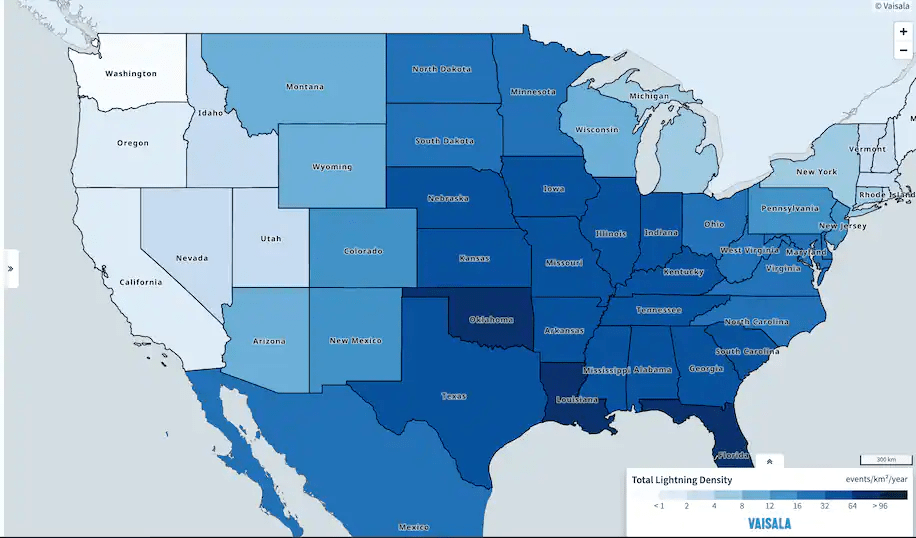
4.20.21 – Washington Post – Thunderstorms in the Sooner State are often more expansive and have more electrical charge
Florida has long been considered the lightning capital of the United States, but a new analysis from Vaisala shows that might not be the case. The company says Oklahoma has overtaken the Sunshine State, at least in recent years, boasting more lightning flashes per square kilometer than any other state in the country.
The findings were shared by Chris Vagasky, a meteorologist and lightning applications manager at Vaisala, a Finnish environmental monitoring company, via Twitter on Tuesday. Since then, the results have surprised meteorologists, many of whom grew up learning that Florida always held the top spot.
Lightning barrage in Oklahoma brings nearly 30,000 flashes within 8 miles
In reality, Oklahoma and Florida are neck and neck — with 83.4 lightning flashes per square kilometer averaged over the past five years in Oklahoma, compared to 82.8 in Florida.
“When the numbers are that close together, it’s hard to say something’s truly taken over the other,” Vagasky said in a phone interview Tuesday. “Florida and Oklahoma are the two most lightning-prone states in the U.S.; the [National Lightning Detection Network] is extremely high-performing, so we’re confident in those numbers.”
Vagasky said Vaisala’s National Lightning Detection Network registers about 95 percent of cloud-to-ground lightning flashes, and between 50 and 60 percent of in-cloud discharges. It senses lightning through stations scattered about the country and the world, with data dating to the late 1980s domestically.
Stations detect lightning by magnetic currents induced in wires by the electromagnetic field that emanates outward from a lightning strike. With sufficient station coverage, distance and location can quickly be deduced.
Vagasky said coverage was equally good in Florida and Oklahoma, allowing for a fair comparison.
The GOES East weather satellite, meanwhile, peers down on the skies from 22,236 miles in space; its Geostationary Lightning Mapper, or GLM, pinpoints lightning by detecting its near-infrared flashes. It’s much better at detecting intra-cloud lightning.
To date, there does not appear to exist a state-by-state climatology of lightning flashes from GLM.
While Oklahoma and Florida are on near equal footing, the two states rack up their annual lightning tallies quite differently. Florida is known for its seemingly daily barrage of sea-breeze thunderstorms during the summertime, while Oklahoma gets fewer storms, but they’re usually larger and yield prolific lightning rates.
Those expansive thunderstorm complexes are called mesoscale convective systems, and they’re a staple of weather on the Plains every spring.
How two thunderstorm complexes kissed over Kansas City
“That’s definitely part of it,” Vagasky said. “In Florida, you get a lot of pulse convection in the spring and summer months … sea breezes interacting. Those storms go up and down pretty quickly, but you get a lot of them.”
Most thunderstorms in Florida last a half-hour to an hour, but they produce turrets of cold air that hit the ground and kick up new updrafts, or pockets of rising air, that birth additional storms.
“In Oklahoma, you have mesoscale convective systems, supercell storms and big complexes that produce a lot of lightning for an extended period of time,” Vagasky said.
In early September, a barrage of lightning brought more than 30,000 flashes to within eight miles of the University of Oklahoma, prompting campus safety alerts as severe weather brought damaging wind and golf-ball-size hail to the region.Advertisement
Oklahoma County, which includes Oklahoma City, averages 120.8 events per square kilometer per year, or about 312.9 per square mile annually.
“But Orange County, Florida has 159 events per square kilometer per year,” said Vagasky. That’s 412.3 per square mile. Orlando is located in Orange County and is home to numerous amusement parks, including Disney World, SeaWorld and Universal Studios.
There were other interesting findings in Vaisala’s data set. Louisiana, for instance, comes in third place nationally, averaging 71.9 events per square kilometer per year.
Alaska, which isn’t covered by the National Lightning Detection Network, wasn’t included in the study — but Vagasky says that the Global Lightning Network detected 415,231 events in Alaska during 2020.
Globally, there were hot spots, but one country stood out in particular.
“Singapore is actually lightning capital of the globe,” said Vagasky, averaging “127 events per square kilometer” per year.Advertisement
Vagasky said that “Vaisala is trying to improve the world through better measurements.” The company also manufactures and operates meteorological observation equipment.
Earth Networks, another environmental monitoring company that operates its own lightning detection network around the world, said its data does not support Oklahoma as having overtaken Florida. The company has more than 1,800 stations that cover 100 countries across the globe.
World record lightning ‘megaflash’ in South America — 440 miles long — confirmed by scientists
In 2020, four of the top five most lightning-prone counties were in Florida, according to Earth Networks. Collier County took the cake, with more than 2 million flashes. In fifth place was Cherry County, Neb., which had a higher proportion of cloud-to-ground strikes.
Even more surprising was that D.C. had a higher flash density than did Oklahoma. Earth Networks says that 441,211,344 lightning flashes occurred across the United States in 2020.
Lightning ‘superbolts’ can be 1,000 times brighter than ordinary flashes, study finds
Its data only takes into account 2020, however, meaning that Vaisala’s data, which spans five years, may still support Oklahoma as being more sparky than Florida.
Regardless, when it comes to lightning safety, the message is the same everywhere: When thunder roars, go indoors.8 Comments
